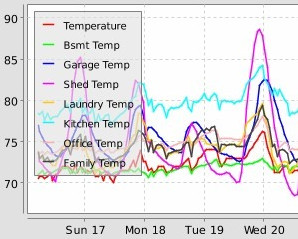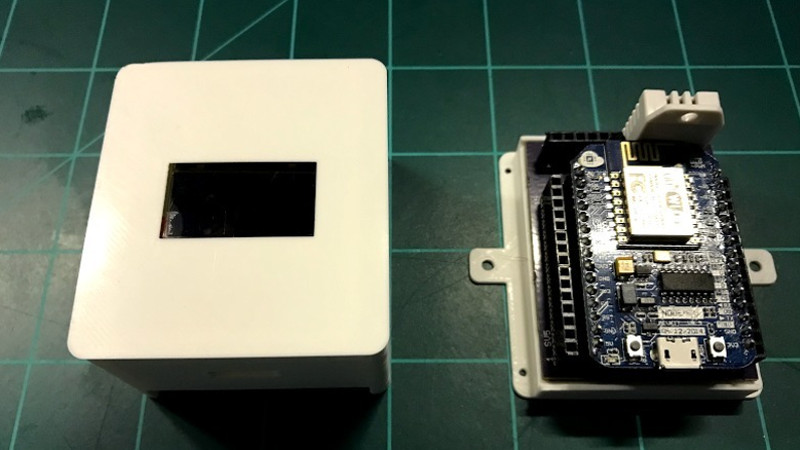It’s often said that “Less is More”, and we think that the chic ESP8266 environmental monitor posted by Thingiverse user [bkpsu] definitely fits the bill. Dubbed “Kube”, the device is a 3D printed white cube with an OLED display in the center, which [bkpsu] says was designed specifically for the approval of his wife. Weirdly, she didn’t like the look of bare PCBs on the wall.

Inside, things are a little more complex. The Kube uses the NodeMCU development board, and a custom breakout that [bkpsu] designed to interface with the display and sensors. For temperature and humidity monitoring, the Kube is using the ever-popular DHT22, and [bkpsu] mentions that he has future plans for things like motion sensors and direct control of RGB LED strips. All the data collected by the Kube is piped into openHAB via MQTT.
On the very detailed Thingiverse page, [bkpsu] gives background information on his design goals for the project, tips for printing out a high-quality case, a parts list with Amazon links, and pinout information for getting it all wired up. The PCB is even available on OSH Park for those who want a Kube of their own.
Even with all the stick home monitoring and automation products on the market today, many hackers simply can’t bring themselves to buying a turn-key commercial product. But we think with the results hackers have been getting rolling their own solutions, they just might be on to something.
















I’ve got one of those in my chicken coop, just not as nice looking.
I had similar setup for this https://github.com/nardev/hepek-iot (final code never went up.. not ready to share it yet..) but what i noticed, the temp sensor is giving like 2-3 C higher temp due to enclosure and being close to hot MCU or voltage regulator..
I have noticed the self-heating as well, even without an enclosure you can gain a degree or two. Add on top of that the poor calibration — all my temperature sensors differ by a degree (Celcius!) or two, and I’m not sure that it reflects reality. But if all you care about is change in temperature, it’s kinda moot.
Here’s an example where heat is carried by the copper pour in a PCB design:
https://hackaday.com/2016/05/06/fail-of-the-week-esp8266-heats-temperature-sensor/
In my experience, the DS18B20 and its derivatives are more accurate than the DHT22. DHT’s always report a value 1 or 2 degrees above what I expect.
I prefer DS18B20 too. Quite accurate, almost free and small! Of course If you don’t need humidity too. :)
bme280 222496414823 for US $1.29 shipped to your door.
Right, as Rumburack said, bme280 is cheap and has good precision. I use it in this sensors mesh project https://hackaday.io/project/20388-home-smart-mesh. Well precision comes from the fact that every sensors has special calibration parameters.
I don’t understand why to use the DHT22. Bosch bme280 gives more data and is better at the same price.
Self heating is a pain, the esp8266 can easily change the reading by simple heat radiation.
It’s hard to find bme280. just sensor anywhere for less than 5EUR .. although those modules from china cost about a 1-2USD… +, i wonder if anyone published proper schematics for bme280???
DHT22 is so widely used, i think even Linux kernel has the driver for it by default :) so, why not :)
I’ve used BME280 in my own weather monitoring setup, but found them to be pretty poor outdoors; first time I rains for awhile the humidity pegs at 100% and stays there. Accordingly to the docs, solution is to take out sensor and bake it in oven for a few hours.
Yeah, no problem…
Don’t feel bad. I worked at a major thermostat manufacturer, and they had precisely this problem. Normally you could compensate for it, but in this case when the furnace fan would turn on, it would blow air through the tiny holes in the wall behind the thermostat until the pocket between the studs was pressurized. This resulted in the measured temperature first being too high, then too low as the fan turned on, then finally too high again.
I have a stupid problem like that. Wall my thermostat is on gets a draft forced down it according to wind, gets super cold air behind. I made a gasket for the thermostat but it still bleeds through, and in general wall is colder than rest of room. I can’t even move it around the room much due to doors, window, where the registers are etc.
Also have an idiot problem, due to it being only free wall, furniture goes against it also, but ppl keep piling crap up below thermostat, getting in danger of blocking it all the time. DON’T PUT THAT THERE!!! Alright alright no need to be an asshole about it. I HAVE TO TELL EVERYONE EVERY FREAKING WEEK OF COURSE I’M AN ASSHOLE ABOUT IT.
Can anyone recommend similar commercial home monitoring products?
There seems to be a gap in the market between 433MHz indoor/outdoor thermometers for a few $$, and room sensors like this – where the commercial ones are an order of magnitude more expensive, even if they don’t have a display. Then you get the Nest/Hive devices, which may be easy to use but still only monitor a single room.
This! ^^ I would buy several remote sensing units if they came with DIP switches to set the “station” number. The base unit should be able to then use multiple stations set points and program a schedule.
Answer is DIY :) I had the same conclusion so started this https://hackaday.io/project/20388-home-smart-mesh
I stayed by the 2.4GHz but extended with ultra cheap (DIY) repeaters with PA LNA up to 1 Km.
As it’s connected to MQTT and Open-Hab, it’s much more open than any other product on the market.
Don’t use a DHT22, they are cr*p, personal experience and corroborated by https://hackaday.com/2017/01/03/humidity-sensor-shootout/
Concur. SHT35 recommended where there would be no exposure to high humidity, SHT31 for areas having high (>78%) humidity. Have found the MaxDetect stuff to be garbage; seldom within spec new, always out of spec after six months.
Reading and understanding product spec sheets. One of the differences between hacking to engineering.
I’m in the process of building something very similar.
With the idea of a ultrasonic range finder being used to determine if a garage door is open or closed stolen from the open garage project, I wanted to add a temp/humidity and CO detector to the setup…
I sometimes use a propane heater in the garage and it produces temperature, humidity and CO, and in large enough quantities any of those things can be dangerous, so I wanted to monitor them, and if I decide they are reaching problematic levels I’ll get an exhaust fan, to help clear them out…
Maybe even add an electric heater that might be able to keep the garage above freezing in the winter… but I’d want to know how much power that would actually take, as it would be a factor in if I go to off peak power in the garage (probably an electric oil heater that I Can run off peak and it will radiate heat for several hours after it’s been shutdown.)
Once the garage is up and running and I plan to do the same sensor bank for the bathroom to deal with the humidity from hot showers there…
I’m piping everything into homeassistant (gave up on openhab when I couldn’t get the openhab 2 upgrade working)